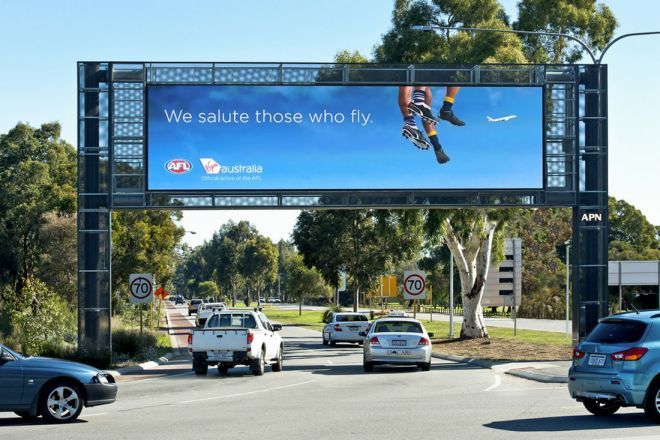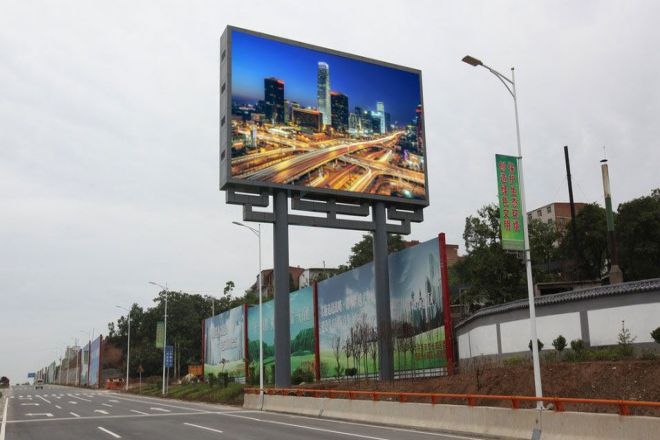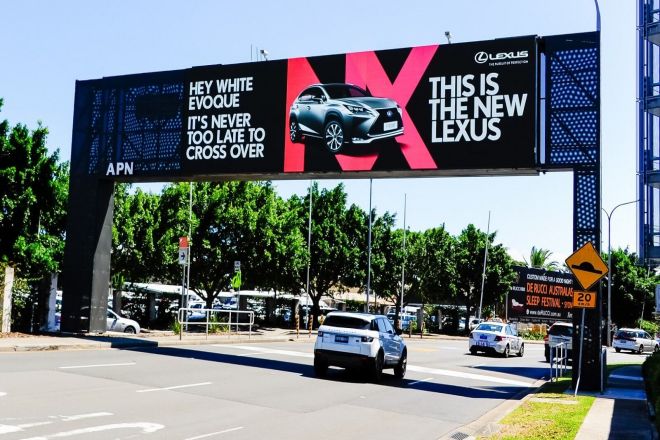Introducción

When you drive across a busy road, have you ever noticed those flashing pantallas led? They are not only embellishments on the city skyline but also invisible guides on your way.
In this era of information explosion, how can these screens accurately capture your sight and convey vital information? What kind of technological power is hidden behind them, and how are they quietly changing our way of travel?
This article will take you deep into the highway scene to find out how these LED screens guide our thinking in the form of questions, replace our travel experience with intuitive pictures, and jointly unveil the mystery behind them.
1. What characteristics do LED screens on highways need to have?
Almost all LED screens on highways are outdoor LED screens, but they also need to have a series of characteristics in design and application. Not all outdoor LED screens can be installed on highways. The following are the main characteristics required for highway LED screens:
1) Alto brillo y amplio ángulo de visión
- Brillo alto:
LED screens must have high enough brightness to maintain clear display effects in strong outdoor light environments. This is because in direct sunlight if the display brightness is insufficient, the driver may not be able to clearly recognize the display content.
- Amplio ángulo de visión:
The display screen needs to have a wide viewing angle to ensure that drivers from different directions can easily read the information.
2). Real-time update capability
- Remote control system:
Highway LED display screens should have the ability of remote control and real-time update so that traffic management departments can quickly respond to changes in road conditions and update display content.
This helps drivers get the latest traffic information in a timely manner, such as accident warnings, traffic congestion, etc.
3). Durabilidad y estabilidad
- Resistencia al clima:
Since highway LED display screens are usually installed in outdoor environments, they need to have good weather resistance, be able to withstand the invasion of bad weather (such as high temperature, low temperature, rain, and snow, etc.), and maintain long-term stable operation.
- Alta fiabilidad:
The electronic components and structural parts of the display screen should be highly reliable to reduce the failure rate and ensure the continuity and accuracy of information.
4). Good visual effect
- Alto contraste:
High contrast helps to improve the clarity of the displayed content and makes it easier for drivers to recognize information.
- Colores brillantes:
Bright colors can attract the driver’s attention and improve the efficiency of information transmission.
5). Diverse display content
- Information richness:
Highway LED display screens should be able to display various types of information, such as traffic instructions, road condition warnings, weather forecasts, advertising, etc., to meet the needs of different scenarios.
- Customization capability:
The display screen should have a certain customization capability so that unique display content can be designed according to the characteristics of different cities and different road sections.
2. What are the benefits of installing LED display screens on highways?

Installing LED display screens on highways brings many benefits, which are not only reflected in the improvement of traffic management efficiency but also involve public safety, information dissemination, economic promotion, and city image. The following are the main benefits of installing LED display screens on highways:
1). Improve traffic management efficiency
- Información de tráfico en tiempo real:
LED display screens can publish traffic information in real-time, including road congestion, traffic accidents, construction sections, etc., to help drivers plan routes in advance and reduce traffic delays caused by unclear road conditions.
- Traffic control guidance:
In special circumstances, such as large-scale events, emergencies, etc., LED display screens can quickly publish traffic control information to guide vehicles to pass in an orderly manner and avoid traffic chaos.
2). Enhance public safety
- Emergency notice release:
When encountering an emergency, such as natural disasters, terrorist attacks, etc., the LED display can quickly issue an emergency notice to remind drivers and pedestrians to pay attention to safety and take corresponding measures.
- Advertencia meteorológica:
The display can also provide real-time weather warning information, such as heavy rain, strong winds, haze, etc., to help drivers take preventive measures and ensure driving safety.
3). Promote information dissemination
- Public information display:
LED display screens are not only a carrier of traffic information, but can also be used to display public information, such as policies and regulations, public service notices, etc., to improve the popularity and dissemination efficiency of information.
LED display screens for commercial purposes can publish various advertisements, provide a publicity platform for businesses, and also bring certain economic benefits to the city.
4). Economic promotion
- Drive the surrounding economy:
The establishment of commercial advertising display screens can attract businesses to place advertisements, drive surrounding commercial activities, and promote local economic development.
- Save operating costs:
Compared with traditional paper posters or banners, LED display screens have lower maintenance costs and longer service life, which helps to reduce urban management costs.
5). Enhance the image of the ciudad.
- Embellecer el paisaje urbano:
Well-designed LED display screens can become a beautiful landscape of the city, enhancing the overall image and beauty of the city.
- Demonstrating technological strength:
The widespread application of LED display screens also demonstrates the city’s strength and innovative spirit in the application of science and technology, which helps to enhance the city’s visibility and attractiveness.
3. Is the highway LED display screen easy to maintain?
In fact, it is asking about the convenience and feasibility of manual maintenance of this display screen in an outdoor environment.
- Location factors:
Highway LED display screens are usually installed on both sides or above the road, at a higher position, and maybe in a busy traffic area.
This means that maintenance personnel need to take safety measures (such as wearing reflective clothing, using safety ropes, etc.) to approach the display screen, which increases the difficulty and complexity of maintenance.
- Accessibility:
Some display screens may be installed in difficult-to-reach locations, such as viaducts, tunnel entrances, etc., which restrict the access of maintenance vehicles and equipment. In addition, if the display screen is blocked by other facilities (such as trees, billboards, etc.), it may also affect the convenience of maintenance.
- Diseño estructural:
Good structural design can improve the convenience of maintenance. For example, if the display screen adopts a modular design, then when a module fails, the module can be replaced separately without disassembling the entire module, saving time and effort.
- Technical difficulty:
Although the technology of LED display screens is constantly developing, some complex faults may still require professional technicians to solve. Therefore, the maintenance team needs to have a certain level of technical skills and experience to ensure that the problem can be quickly and accurately located and solved.
- Suministro de repuestos:
In order to ensure the feasibility of maintenance, it is necessary to ensure sufficient spare parts supply. This includes key components such as LED lamp beads, power modules, and control cards. If the spare parts supply is insufficient or the quality is unreliable, it will seriously affect the efficiency and effectiveness of maintenance.
- Maintenance plan:
Formulating a reasonable maintenance plan is the key to ensuring the long-term and stable operation of the display. This includes regular inspection, cleaning, calibration and other routine maintenance work, as well as emergency response plans for sudden failures. Through advance planning and preparation, the difficulty and cost of maintenance can be reduced.
4. Requirements for protection level of highway LED display screens

Highway LED display screens have high protection requirements, mainly because they are usually installed in outdoor environments and need to withstand various severe weather and human factors. The following are the specific requirements for the protection level of highway LED display screens:
1). Dustproof level requirements
- High-level dustproof:
Highway LED display screens need to have a high dustproof level to prevent solid foreign matter, such as dust and particulate matter, from entering the interior of the display screen, affecting its normal operation and display effect.
Generally speaking, the dustproof level of outdoor LED display screens should reach IP5X or higher, where IP6X means that solid foreign objects are completely prevented from entering.
2). Waterproof level requirements
- Strong waterproof ability:
Since highway LED display screens are often exposed to outdoor environments, they must have a strong waterproof ability to resist the intrusion of liquids such as rain and snow.
For outdoor display screens, the waterproof level should be at least IPX4 or above, where IPX4 means that it can prevent the intrusion of splashing water droplets, while higher levels, such as IPX6, IPX7, and even IPX8 respectively, indicate that they can resist stronger water jets, short-term immersion in water, and long-term immersion in water.
3). Comprehensive protection level requirements
- Comprehensive considerations:
When choosing a highway LED display screen, its dustproof and waterproof levels need to be comprehensively considered to ensure that the display screen can operate stably in various harsh environments.
Generally speaking, the protection level of outdoor LED display screens should reach IP65 or above, which can effectively prevent dust from entering and resist the intrusion of jet water.
4). Otras Consideraciones
- Resistencia al clima:
In addition to dustproof and waterproof levels, highway LED display screens also need to have good weather resistance to resist damage caused by environmental factors such as high temperature, low temperature, and ultraviolet rays.
- Resistencia a los terremotos:
Due to the complex and changeable highway environment, the display screen also needs to have a certain earthquake resistance to cope with possible mechanical shock and vibration.
- Fácil de mantener:
In order to facilitate later maintenance and upkeep, the structural design of the highway LED display screen should be reasonable and easy to disassemble and replace parts.
Conclusión
Through this exploration, it is not difficult to find that the LED display screens on the road have become an indispensable part of the modern transportation system. They not only bear the heavy responsibility of transmitting information and guiding traffic but are also a vivid embodiment of scientific and technological progress and smart city construction.
In the future, with the continuous innovation of technology and the continuous expansion of applications, LED display screens will play a more important role in the field of highway transportation, bringing us a more convenient, safe, and green travel experience.
Finalmente, si quieres saber más sobre las pantallas LED, Por favor póngase en contacto con nosotros.
